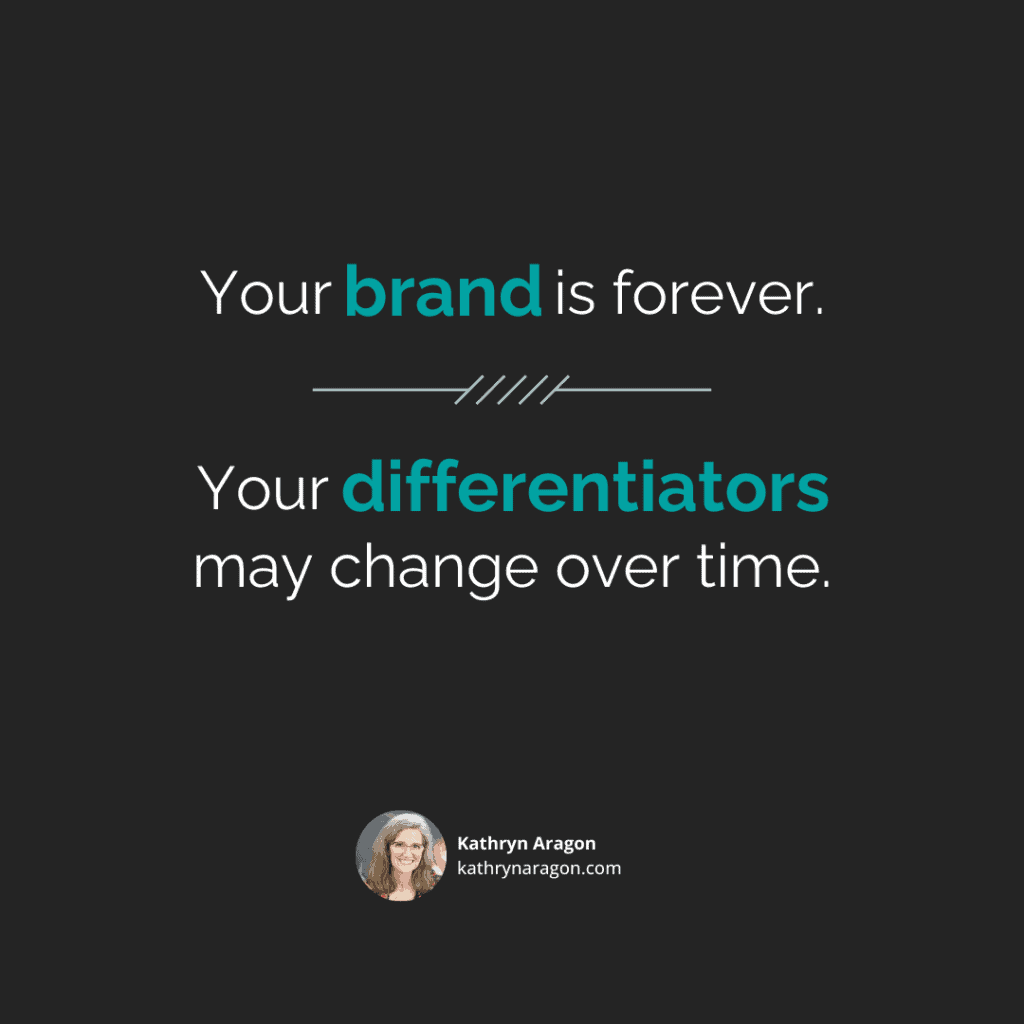What do Amazon, Apple, and Mercedes-Benz have in common?
They’re among the world’s most valuable brands. We recognize them by their logo, a tagline, or a jingle. And we stand in line for hours to be among the first to own one of their products.
These companies are associated with quality. You only have to see their name to be sure you’re getting a good product.
That’s the secret to success.
When a logo or a tagline can drive sales without any supporting content or sales copy, you know you’ve arrived.
But that won’t happen by accident. You’ve got to build a brand that’s instantly recognizable. And to do that, you need to clearly define your brand and infuse it into everything: your message, your website design, the topics you talk about and how you talk about them.
Unfortunately, in a world where you can have a fully functional business website, blog, or eCommerce store up and running in less than 24 hours, often written by the same AI tool everyone else is using, branding and producing branded content is often an afterthought.
Here’s why it’s important, as well as four steps to build your brand and how to create a brand that’s truly different.
Branding 101
Simply put, if you want to gain market share and win consumer loyalty, you need to be able to communicate in a voice, tone, and style that emanates from your business’s core principles.
All your branded content — your About page, product descriptions, blog posts, social media, and more — should deliver a clear message of what your business is about. And it should be distinctively “you.”
Only then will you see the higher conversion rates, increased profits, word-of-mouth referrals, and recurring revenue we see in Apple, Amazon, and Mercedes-Benz.
So let’s talk about branding, and how you can use your content to build your brand.
How do you infuse your content with a unique brand personality? Here are 4 strategies to build a better brand — and express it in high-value content and sales copy.
1. Start at Your Core
To create a strong brand, you first must define your business’s central mission and marketing message.
While you are understandably anxious to drive sales, you’ll have more success if you slow down and build a solid foundation first.
What is the essence of who you are? What you want consumers to think of when they come in contact with your brand? Why should anyone buy from you instead of your competitors?
The answers to these questions are the foundation of your brand and give you some conceptual pillars to build on.
Need some inspiration?
Look around you. Look at how other successful brands are communicating their values and mission.
Look at your competition too. Not only do you want to identify their positives, you should also find ways to differentiate your business from theirs.
2. Build a Brand “Bible”
The next step to build a better brand is to create a brand strategy — establish how you’ll translate your mission into messaging. If your messaging and style are always changing, no one will know who you are at your core.
Big mistake.
You need to have a distinct personality and approach that set you apart.
The secret to making that happen is consistency. When a customer comes in contact with your branded content, it should be like running into an old friend. They recognize you by the colors you wear, the sound of your voice, and the topics you talk about.
But to achieve that level of consistency, you need to make some hard decisions about how you’ll handle every detail related to your brand, your standards, your look and feel, and your messaging.
Then you need to document it. This document is your brand bible.
It should include everything from the tone you’d like to project to the words you use to describe your business and even your spelling and grammar preferences.
Don’t forget to include design choices too: fonts, brand colors, and even your graphics style. Then, cook up some examples that portray the style, personality, and substance you’re shooting for.
3. Find Your Brand Voice
When attempting to nail down your brand’s voice, your best inspiration will likely come from the people who know your business best. Speak to everyone — from the CEO and CFO to the sales team and human resources — and collect the words and phrases they use to describe your business.
Once you’ve gathered input from everyone, pull out the things that capture your true personality, the stylistic “ticks” that reflect your company’s culture and style. Now, add them to your brand bible.
Using these words and phrases in all your content will help project a genuine voice. As a bonus, they’ll also serve as a treasure trove of content ideas: blog posts, press releases, and even marketing campaigns that perfectly capture your brand’s personality.
4. Scrutinize, Analyze, and Adjust
Don’t stop there. You want to be sure your brand resonates with your target audience and actually drives results.
First, verify your branding will produce the right impression by soliciting feedback. Do some user testing to be sure it will attract your best customers and drive sales. Make adjustments as necessary if it doesn’t.
Then create a system that ensures consistency and quality control in all your content.
You see, your brand bible is a guideline, but it’s still necessary to review every piece of content for branding as well as messaging. In that review, ask yourself:
- Does every element meet your copy and design standards?
- Does the finished product look, sound, and feel like your brand?
- Is every detail right?
Once your content is live, analyze your audience’s response. You may also be able to interact with people directly through forums and social media. Your goal is to confirm whether your content is delivering the desired message and creating the right impression.
Branding vs. Differentiation
Branding and differentiation work together to make your brand or product stand out. Reading their definitions, it makes sense:
Branding is the unique identity your product/service has that distinguishes it from competitors.
Differentiation is the act of highlighting the things that make your product/service unique in the marketplace.
They’re essentially two sides of one coin, and that coin is about standing out in a crowded marketplace.
Let’s start with the obvious: You need both.
Here’s the less obvious: The same image or methodology can be used to create your brand and to differentiate your product from your competitors’. But not always, and certainly not forever.
A Brand Is a Long-Term Investment
Your brand can and should last a long time. You may choose to update it to keep up with the times, but there are elements that should never change.
McDonald’s golden arches are a good example. The restaurant design could changed. The mascots could change. But those arches should never change, because that’s the brand.

Differentiation Will Change Over Time
As technology evolves, new players enter the market, or buyer behavior shifts, the power of your differentiation may weaken or even disappear.
Netflix adopted streaming technology when it was new. Blockbuster didn’t. They stuck with their original differentiation strategy — having the largest library of videos available for rent and knowledgeable employees who could help customers find a movie they’d like.
The trouble was, as the world became more digital, no one cared anymore.
What was once a competitive advantage became a liability.
It’s also important to understand the difference between a brand and a differentiator.
Coca-Cola’s brand is iconic. You only need to see Coca-Cola red, the script logo, or its uniquely shaped bottle, and you know you’re getting a Coke. That a powerful brand.
But it’s not differentiation.
When Coca-Cola was invented in 1886, they had some huge differentiators: carbonation; their sweet, syrupy flavor; a non-alcoholic refreshment (soft, not hard).
But as the market developed, carbonation was no longer a differentiator. Soft drinks became a category.
The flavor itself was almost recreated by market challenger Pepsi, so that’s no longer a differentiator.
And now, buyers are looking for healthier options for their flavored drinks. The sweet syrup is a liability, not a differentiator.
You Need Both
To grow your business, you need a strong brand and some differentiators that set you apart from your competition.
You can start with brand colors and a logo, but think about the bigger picture.
One of my clients created a brand around the science of what they do. They call themselves scientists and wear lab coats when they speak on stage.
The scientific method has been their differentiator for years. But like Coke, their competitors are encroaching. It may be time to find a new differentiator.
Always remember: Your brand is forever. Your differentiators may change over time.

Final Thoughts
People typically make purchase decisions based on quality, selection, and pricing. But they also take the brand into consideration. When your company is built on the foundation of a strong, recognizable brand, everything gets easier: marketing, traffic generation, list building, sales — and retention.
So take a moment and evaluate your own brand. Does it instantly communicate who you are and what you do? Does it win loyalty and trust?
If not, you need to build a better brand.
Need help? I work with companies to create a holistic, revenue-first strategy that helps you SCALE. Contact me today to learn more.


